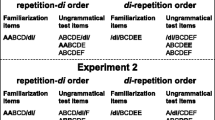Abstract
Observations from philosophy and psychology heavily favor the Empiricist tenet that many lexical concepts are learned. However, many observations also heavily favor the Nativist tenet that such concepts are representationally atomic. Fodor (The language of thought, 1975, In J. Fodor (Ed.) Representations: Philosophical essays on the foundations of cognitive science, 1981, LOT2: The language of thought revisited, 2008) has famously argued that representationally atomic concepts cannot be learned, at least not learned by hypothesis formation and testing. Concept theorists who want to preserve observations about concept learning have developed acquisition models on which the acquired concepts are either non-atomic or are acquired by a process that doesn’t involve hypothesis formation and testing. I offer a model, Baptizing Meanings for Concepts (BMC), in which representationally atomic concepts are learned by hypothesis formation and testing. The concepts are learned by the agent’s hypothesizing the existence of a latent/hidden/imperceptible property in objects to explain the objects’ perceptible similarities. Once a hidden property is hypothesized, a new atomic mental name is assigned to it, and this atomic name becomes the concept. Any connections between the name and the representations involved in linking the name to its referent are stored as contingent. Further experience may give the agent reason to revise its hypotheses about latent properties as explanations for its observations. I discuss a software robot implementation of the BMC process that uses a Bayesian learning network. The implementation provides an existence proof of the possibility of learning representationally atomic concepts by hypothesis formation and testing.






Similar content being viewed by others
Notes
I first explored this account in a poster called “The Mental Coining of Terms” at the 2007 meeting of the Society for Philosophy and Psychology.
This is how ‘concept’ is used among cognitive scientists, in contrast with the philosopher’s use of ‘concept’ for the meanings of linguistic and/or mental terms. I distinguish between a token concept as a stored mental entity in an individual cognizer and the tokenizing of a concept that happens when a cognizer brings the stored entity into occurrent thought-processing.
What is on offer is not a metaphysical account of what it is to have a concept. Whatever it is to have a concept, the BMC process offers a pathway to that state of affairs.
I hesitate to call the hidden/latent/unobservable property an essence, because different properties may be posited to explain different collections of known properties across different collections of objects (apple, fruit, McIntosh, etc.).
Some psychologists do seem to be trying to do something like this when they ask subjects to figure out the meaning of a linguistic term, “blik”. That, however, is not what it is to learn a concept as I have characterized it, even if it involves hypothesis formation and testing. There is a genuine question about whether lexical concepts, like APPLE, are learned by an inferential process that is akin to the acquisition of phrasal concepts, like TALKING APPLE.
It’s not quite a mental version of the linguistic process because the linguistic process relies on concept possession, for dealing with the qua-problem in particular, as discussed later in this paper.
No claims are being made presently about the actual perceptual space of human beings. The example serves merely to illustrate the kind of process that allows for the acquisition of atomic concepts.
Frege’s Puzzle is introduced in his (1892).
A full defense of such concepts as genuinely atomic appears in my doctoral dissertation (Oved 2009).
A real-world robot was also built, as reported in Rebguns et al. (2011).
Notice that Putnam is careful to include ‘liquid’ in the presupposition, to ensure that the term ‘water’ gets hooked onto the property of being water rather than any of the other properties in the sample.
References
Burge, T. (1979). Individualism and the mental. Midwest Studies in Philosophy, 4, 73–121.
Carey, S. (1985). Conceptual change in childhood. Cambridge, MA: The MIT Press.
Carey, S. (2009). The origin of concepts. Oxford: Oxford University Press.
Fodor, J. A. (1975). The language of thought. New York: Thomas Y. Crowell.
Fodor, J. A. (1981). The present status of the innateness controversy. In J. Fodor (Ed.), Representations: Philosophical essays on the foundations of cognitive science (pp. 257–316). Cambridge, MA: MIT Press.
Fodor, J. A. (1983). The modularity of mind. Cambridge: MIT Press.
Fodor, J. A. (1985). Fodor’s guide to mental representation. Mind, 94, 76–100.
Fodor, J. A. (1998). Concepts: Where cognitive science went wrong. New York: Oxford University Press.
Fodor, J. A. (2008). LOT2: The language of thought revisited. New York: Oxford University Press.
Frege, G. (1892) Über Sinn und Bedeutung. In Zeitschrift für Philosophie und philosophische Kritik, 100, 25–50. Translated as ‘On Sense and Reference’ by M. Black in Translations from the Philosophical Writings of Gottlob Frege (3rd ed.), P. Geach and M. Black (eds. and trans.), Oxford: Blackwell, 1980.
Gopnik, A., Glymour, C., Sobel, D. M., Schulz, L. E., Kushnir, T., & Danks, D. (2004). A theory of causal learning in children: Causal maps and Bayes nets. Psychological Review, 111(1), 3–32.
Gopnik, A., & Schulz, L. (2007). Causal learning: Psychology, philosophy, and computation. Oxford: Oxford University Press.
Gopnik, A., & Wellman, H. (2012). Reconstructing constructivism: Causal models, Bayesian learning mechanisms, and the theory theory. Psychological Bulletin, 138(6), 1085–1108.
Kemp, C., Perfors, A., & Tennenbaum, J. (2007). Learning overhypotheses with hierarchical Bayesian models. Developmental Science, 10, 307–321.
Kripke, S. A. (1972). Naming and necessity. Cambridge, MA: Harvard University Press.
Locke, J. (1690). An essay concerning human understanding. London: Thomas Basset.
Margolis, E. (1998). How to acquire a concept. Mind and Language, 13(3), 347–369.
Matthews, R. (2007). The measure of mind: Propositional attitudes and their attribution. Oxford: Oxford University Press.
Mitchell, T. (1997). Machine learning. New York: McGraw Hill.
Oved, I. (2009). Baptizing meanings for concepts. Doctoral Dissertation. Rutgers University.
Oved, I., & Fasel, I. (2010). Philosophically inspired concept acquisition for artificial general intelligence. In Pthroceedings of the 4th Conference of Artificial General Intelligence.
Pearl, J. (2000). Causality: Models, reasoning, and inference (1st ed.). Cambridge: Cambridge University Press.
Pearl, J. (2009). Causality: Models, reasoning, and inference (2nd ed.). Cambridge: Cambridge University Press.
Putnam, H. (1975). The meaning of meaning. In H. Putnam (Ed.), Philosophical papers: Mind, language and reality (Vol. 2, pp. 215–271). Cambridge: Cambridge University Press.
Rebguns, A., Ford, D., & Fasel, I. (2011). InfoMax control for acoustic exploration of objects by a mobile robot. AAAI Workshop on Lifelong Learning, 2011.
Rupert, R. (2001). Coining terms in the language of thought: Innateness, emergence, and the lot of Cummins’s argument against the causal theory of mental content. Journal of Philosophy, 98, 499–530.
Soames, S. (2002). Beyond rigidity: The unfinished semantic agenda of naming and necessity. Oxford: Oxford University Press.
Vallabha, G. K., McClelland, J. L., Pons, F., Werker, J. F., & Amano, S. (2007). Unsupervised learning of vowel categories from infant-directed speech. Proceedings of the National Academy of Sciences, 104, 33.
Wilt, A., Fasel, I., Mafi, N., Morrison, C., & Oved, I. (submitted). Unsupervised concept discovery through intrinsically motivated exploration.
Xu, F., & Tenenbaum, J. (2007). Sensitivity to sampling in Bayesian word learning. Developmental Science, 10, 288–297.
Author information
Authors and Affiliations
Corresponding author
Rights and permissions
About this article
Cite this article
Oved, I. Hypothesis formation and testing in the acquisition of representationally simple concepts. Philos Stud 172, 227–247 (2015). https://doi.org/10.1007/s11098-014-0291-2
Published:
Issue Date:
DOI: https://doi.org/10.1007/s11098-014-0291-2




